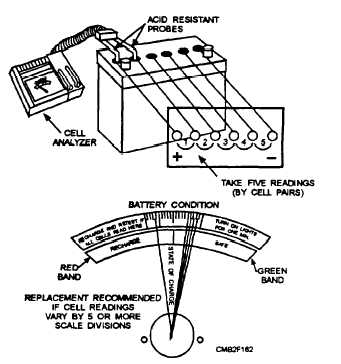If the voltmeter reading is .5 volts or above, there is high resistance at the battery cable connection. This indicates that the battery connections need to be cleaned. A good, clean battery will have less than a .5 volt drop.
BATTERY VOLTAGE TEST. - The battery voltage test is done by measuring total battery voltage with an accurate voltmeter or a special battery tester (fig. 2-8). This test determines the general state of charge and battery condition quickly.
The battery voltage test is use d on maintenance-free batteries because these batteries do not have caps that can be removed for testing with a hydrometer. To perform this test, connect the voltmeter or battery tester across the battery terminals. Turn on the vehicle headlights or heater blower to provide a light load. Now read the meter or tester. A well-charged battery should have over 12 volts. If the meter reads approximately 11.5 volts, the battery is not charged adequately, or it may be defective.
CELL VOLTAGE TEST. - The cell voltage test will let you know if the battery is discharged or defective. Like a hydrometer cell test, if the voltage reading on one or more cells is .2 volts or more lower than the other cells, the battery must be replaced.
To perform a cell voltage test (fig. 2-9), use a low voltage reading voltmeter with special cadmium (acid resistant metal) tips. Insert the tips into each cell, starting at one end of the battery and work your way to the other. Test each cell carefully. If the cells are low, but equal, recharging usually will restore the battery. If cell voltage readings vary more than .2 volts, the battery is BAD.

Figure 2-8. - Battery voltage test performed with a battery tester.

Figure 2-9. - Cell voltage test.
BATTERY DRAIN TEST. - A battery drain test checks for abnormal current draw with the ignition off. If a battery goes dead without being used, you need to check for a current drain.
To perform a battery drain test, set up an ammeter, as shown in figure 2-10. Pull the fuse if the vehicle has a dash clock. Close all doors and trunk (if applicable). Then read the ammeter. If everything is off, there should be a zero reading. Any reading indicates a problem. To help pinpoint the problem, pull fuses one at a time until there is a zero reading on the ammeter. This action isolates the circuit that has the problem.
BATTERY CAPACITY TEST. - A battery load test, also termed a battery capacity test, is the best method to check battery condition. The battery load test measures the current output and performance of the battery under full current load. It is one of the most common and informative battery tests used today.
Before load testing a battery, you must calculate how much current draw should be applied to the battery. If the ampere-hour rating of the battery is given, load the battery to three times its amp-hour rating. For example, if the battery is rated at 60 amp- hours, test the battery at 180 amps (60 x 3 = 180). The majority of the batteries are now rated in SAE cold- cranking amps, instead of amp-hours. To determine the load test for these batteries, divide the cold-crank
Continue Reading